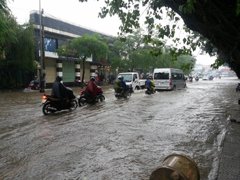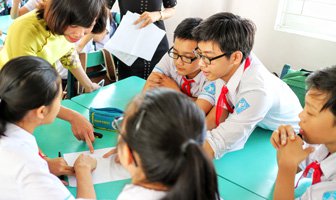“NIHONGO Partners” and Hue’s Japanese-Language Teachers
The Japan Foundation Center for Cultural Exchange in Vietnam (Hue)
KONDO Maiko
My Third and Final Year in Hue
My three years in Hue is finally coming to an end. Vietnam’s wave of economic development has swept over even Hue over the past three years, and even to my untrained eyes the look of the city has changed substantially. A famous Vietnamese mall is constructing a glass-covered high-rise building the likes of which Hue has never seen. The number of women driving cars has also grown a great deal over these three years. A national cafe chain that up to now had no presence in Hue has opened two cafes in the past year, and Taiwanese milk tea cafes have also sprung up one after the other.
On the other hand, my third year’s final rainy season triggered Hue’s famous flooding. Hue’s sewer system is underdeveloped, and due to the heavy rain low-lying land in particular was damaged by inundation above floor level, and in outlying villages a large number of people perished or were reported missing in what was the heaviest flooding Hue had seen since 1999. Furthermore, the Huong River that flows through the center of Hue overflowed and submerged the town area, which resulted in schools having to close for up to one week. The development of Hue’s sewer system continues even now, based on Japan’s ODA budget.
“NIHONGO Partners” and Japanese Culture Experiences!
The “NIHONGO Partners” program began from fiscal 2015, and as of 2018 there are 29 individuals dispatched across Vietnam, including four in Hue, as the fourth batch of NIHONGO Partners. This year I visited all the locations where NIHONGO Partners are posted and was able to observe their activities in the classroom and provide them with advice.
This year is the 45th anniversary of the establishment of diplomatic relations between Japan and Vietnam, and various events are being held in a variety of locations. Japan and Vietnam have built a superb amicable relationship over this 45-year period, I believe. The number of Japanese living in Vietnam is increasing every year, and inside Japan also, Vietnam has entered the spotlight as a tourism destination in Asia.
Nevertheless, in most regions, students studying Japanese in the classroom face limited opportunities to speak Japanese to Japanese people. Even if NIHONGO Partners only visit classrooms once a week, they provide a valuable opportunity for the students to speak Japanese to a Japanese person, and I feel this is having a significant impact on the students, who are at an impressionable age.

The streets of Hue submerged by heavy rain

Third batch of Short-Term “NIHONGO Partners”
Heading out of the classroom to try pushing sumo
Meanwhile, from fiscal 2017 Short-Term “NIHONGO Partners” began being dispatched. Short-Term NIHONGO Partners participate as a group and are active for a period of two weeks. Thus far, four groups of university students have been dispatched. The first batch was dispatched to Hanoi City and Haiphong City in northern Vietnam, the second batch was dispatched to Hue Province and Da Nang City in central Vietnam, and in the third batch, two groups were dispatched to Binh Duong Province and Ba Ria-Vung Tau Province in the south. Because all of the Short-Term NIHONGO Partners thus far have been university student groups, they have energetically showcased the Japanese culture. Even school students for whom the Japanese language is not normally a strong point have been intrigued by these “older brothers” and “older sisters” from Japan, and it has been impressive to see them taking part so enjoyably.
Over the two-week period the Short-Term NIHONGO Partners visited a number of schools in each region and held Japanese culture introductions. Amid this busy schedule, I believe they got to experience Vietnam with “all five senses” as a result not only of interacting with students, but also with the university students who served as volunteer interpreters, Vietnamese people on the street, and through meals and so on.
Continuing to Rise to the Challenge of Being a Teacher From Now On
Accompanying growth in Japanese-language education at secondary educational level in Vietnam, the number of teachers has been increasing even since I was dispatched to the country. On the other hand, the number of people providing assistance is limited, and so it has become difficult to offer plentiful support to all teachers. In light of that, the Japan Foundation Center for Cultural Exchange in Vietnam has shifted to a system in which the teachers themselves engage in enhancing their teaching skills independently. The details can be found here, but in this report I would like to introduce the situation for teachers who participated from Hue.
Two veteran teachers who had taken part in training in Japan in the summer of 2017 participated from Hue. The two teachers explained that “We were able to persevere for the very reason that we encourage one another, and have a relationship in which we are able to exchange views,” and this is genuinely the case, I believe. The people of Hue are generally said to have modest and unobtrusive personalities, and given that they are not accustomed to taking on new challenges by themselves, I imagine taking that first step would have required courage. I expect that through this year’s efforts, they were able to experience a sense of achievement in accomplishing this challenge, which presented a large number of tasks and increased the burdens they imposed on themselves, and gain firsthand experience of the “student-centered” class management that they had been thinking about since last year.
In this way, the more senior teachers who drive secondary education in Hue are conscious of improving their teaching skills and continue to make an effort to do so. I get the feeling that thanks to those efforts, the more junior colleagues are striving to follow suit also. Even with Japanese-language education, it has been a long time since 21st Century-type was mentioned, but teachers themselves must first become 21st Century-type teachers. It is my hope that the Japan Foundation Center for Cultural Exchange in Vietnam will be able to roll out assistance throughout the country so that this desire by the teachers themselves to continue to learn can be encouraged further.
- What We Do Top
- Arts and Cultural Exchange [Culture]
- Japanese-Language Education Overseas [Language]
- Japanese-Language Education Overseas [Language] Top
- Learn Japanese-language
- Teach Japanese-language
- Take Japanese-Language Test
- Know about Japanese-language education abroad
- The Japanese-Language Institute, Urawa
- The Japanese-Language Institute, Kansai
- Japanese-Language Programs for Foreign Specified Skilled Worker Candidates
- Japanese Language Education for Japanese Children Resident Overseas and for the Descendants of Migrants
- Archives
- Japanese Studies and Global Partnerships [Dialogue]
- JF digital collection
- Other Programs / Programs to Commemorate Exchange Year
- Awards and Prizes
- Publications
